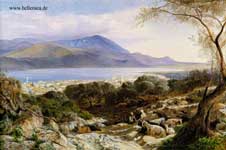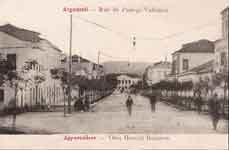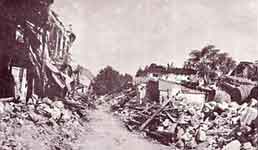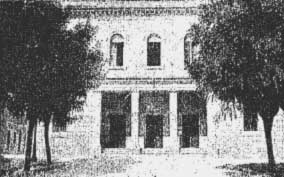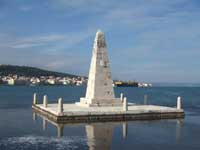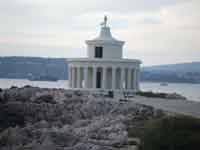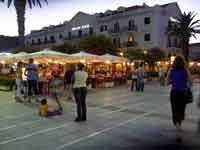.
Administrative Region : Ionian Islands
Regional unit : Kefalonia
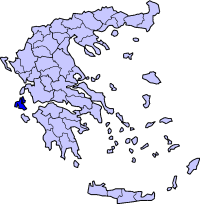
|
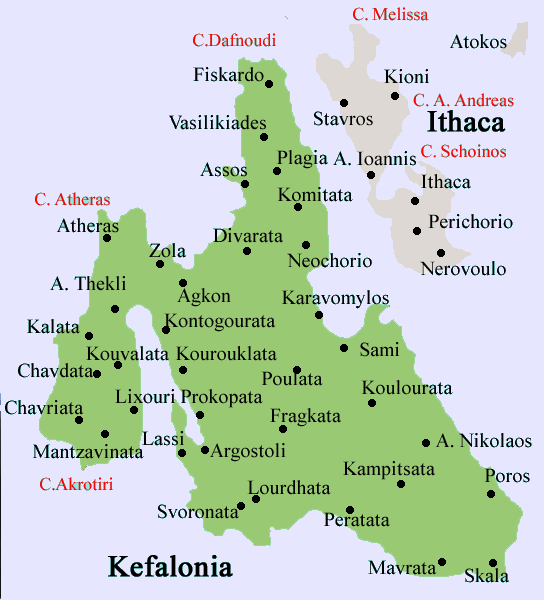 |
Argostoli (Greek: Αργοστόλι, Katharevousa: Αργοστόλιον) is a town and a former municipality on the island of Kefalonia, Ionian Islands, Greece. Since the 2011 local government reform it is part of the municipality Kefalonia, of which it is a municipal unit.[1] It has been the capital and administrative centre of Kefalonia since 1757, following a population shift down from the old capital of Agios Georgios (also known as Kastro) to take advantage of the trading opportunities provided by the sheltered bay upon which Argostoli sits. Argostoli developed in to one of the busiest ports in Greece, leading to prosperity and growth. The 2001 census recorded a population of 12,589 in the Argostoli municipal unit. Its largest towns are Argostóli (pop. 9,037), Dilináta (739), Farakláta (411), and Kardakáta (362).
Urban landscape
Gravour of Argostoli, c.1757.
To the east of Argostoli, at the end of the bay, beneath the aforementioned Castle of St. George, sits the Koutavos Lagoon, a feeding ground for the Loggerhead turtles (Caretta caretta). Now a nature reserve, the Koutavos Lagoon was once an almost impassable swamp where mosquitoes and malaria were rife. Under the British governor of the island, General Sir Charles James Napier, a wooden bridge was constructed across the lagoon in 1813 by Colonel Charles Philip de Bosset, a Swiss engineer in the employ of the British army.
Four years later stone arches were added and, after some 26 years, the entire bridge was rebuilt in stone. In continuous use until 2005, this narrow bridge is now closed to traffic, awaiting renovation by the Greek Ministry of Culture. Almost halfway along the Drepano Bridge stands a stone column built by the British to celebrate their presence.
The coastal road out of Argostoli to the west was known during the Venetian period as the ‘Piccolo Gyro’. Along the Piccolo Gyro, in the Vlikha area facing Lixouri, lie the ‘Swallow Holes’ of Katovothres, a geological phenomenon. Sea water disappears underground and travels under the island, re-emerging some fourteen days later in the Karavomylos area of Sami, having passed through the nearby, underground Melissani lake. The power of this sea water was harnessed, in 1835, to power a water mill. Further along the Piccolo Gyro is the Agion Theodoron lighthouse, named after the small adjacent church. More commonly known as the Fanari lighthouse, this too was built during the British occupation, in 1829. The original building was destroyed in the earthquake of 1953, the recently restored present structure was rebuilt, complete with Doric-style columns, from the original plans.
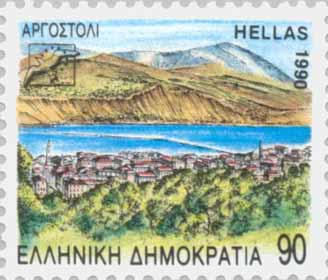
Buildings that weren’t shattered by German bombing in 1943 were destroyed in 1953 by the earthquake that razed virtually all of Kefalonia, apart from the Fiskardo area, to the ground.
Opposite the Archaeological Museum of Argostoli are the law courts, originally constructed by the British with stone from the Cyclopean site at nearby Krani. Along Lithostroto, next to the Catholic Church, is a tiny museum (open some mornings and most evenings) dedicated to the soldiers of the Acqui Division. A little further along is the Bell Tower. Rebuilt in 1985 to house the original clock mechanism.
Subdivisions
Following the “Kapodistrias Law” of 1997, communities around the town united to form a larger municipality of Argostoli, which included the settlements of Spilia, Helmata, Kompothekrata, Lassi, Minies and ten former communities: Agona, Davgata, Dilinata, Zola, Thinia, Kourouklata, Nifi, Troyiannata, Faraklata and Farsa. This municipality, a municipal unit of the municipality of Kefalonia since 2011, was subdivided into the following municipal districts (communities since 2011). Constituent villages are given in brackets:
Agkonas
Argostoli (Argostoli, Kokolata, Kompothekrata, Minia)
Davgata
Dilinata
Faraklata (Faraklata, Drapano, Prokopata, Razata)
Farsa
Thinaia (Kardakata)
Kourouklata
Nyfi
Troianata (Troianata, Demoutsanata, Mitakata)
Zola
Inside the castle of St.George near Argostoli.
Koutavos Lagoon.
Transportation
Between the Koutavos Lagoon and the Drepano Bridge is the new bus station which connects Argostoli with the other towns and some of the villages on the island, as well as with Athens and Patras. The old bus station, just past these market stalls, is likely to accommodate a proposed seaplane service connecting Argostoli with Patras, due to commence Spring 2006. The main ferry port, connecting Argostoli with the mainland (via Kyllini) and Zakynthos (also known as Zante) is next to this building with the Lixouri ferry (once an hour in winter, twice an hour in summer) docking a little further along.
Car ferry service to Kyllini (mainland) and Zakynthos (Zante)
Car ferry to Lixouri
KTEL Bus service to Athens, via Kyllini, Patras and the Corinth Canal bridge
Infrequent bus service to Poros, Sami, Skala, Fiskardo and various villages en route
Frequent summer service to Lassi
NO bus service to Kefalonia Airport
Scheduled flights to Zakynthos and Athens, charter flight in summer, via Kefalonia Airport
Seaplane service, Argostoli - Patras (due Spring 2006)
Taxis from Plateia Valianos and seafront, car and motorcycle/scooter hire
Historical population
Year Town population Municipality population
1981 7,164 -
1991 7,420 9,918
2001 9,522 12,589
People
Gerasimos Arsenis, politician
Aris Maliagros (1895–1984), actor
Andreas Metaxas (1786–1860), politician
Ioannis Metaxas (1871–1941), general, politician and dictator
Constantine Phaulkon (1647–1688), merchant and adventurer
Antonis Tritsis (1937–1992), mayor of Athens
Christian Zervos (1889–1970), art collector, writer and publisher
International relations
Argostoli is twinned with:
Serbia Šabac in Serbia.
See also : Kefalonia island
|
Municipalities and communities of the Kefalonia Prefecture Argostoli | Eleios-Pronnoi | Erisos | Ithaca | Leivathos | Paliki | Pylaros | Sami |
| Municipal unit Argostoli |
|---|
| Municipal Community Argostoli |
| Argostoli (Αργοστόλι το) |
| Kokolata (Κοκολάτα τα) |
| Kompothekrata (Κομποθεκράτα τα) |
| Minia (Μηνιά η) |
| Community Agkonas |
| Agkonas (Αγκών ο) |
| Community Davgata |
| Davgata (Δαυγάτα τα) |
| Community Dilinata |
| Dilinata (Διλινάτα τα) |
| Community Zola |
| Zola (Ζόλα τα) |
| Community Thinaia |
| Kardakata (Καρδακάτα τα) |
| Community Kourouklata |
| Kourouklata (Κουρουκλάτα τα) |
| Community Nyfio |
| Nyfio (Νύφιον το) |
| Community Troianata |
| Demoutsantata (Δεμουτσαντάτα τα) |
| Mitakata (Μιτακάτα τα) |
| Troianata (Τρωιανάτα τα) |
| Community Faraklata |
| Drapano (Δράπανον το) |
| Prokopata (Προκοπάτα τα) |
| Razata (Ραζάτα τα) |
| Faraklata (Φαρακλάτα τα) |
| Community Farsa |
| Farsa (Φάρσα τα) |
Greece :
A - B - C - D - E - F - G - H - I - J - K - L - M -
N - O - P - Q - R - S - T - U - V - W - X - Y - Z
| Ancient Greece
Science, Technology , Medicine , Warfare, , Biographies , Life , Cities/Places/Maps , Arts , Literature , Philosophy ,Olympics, Mythology , History , Images Medieval Greece / Byzantine Empire Science, Technology, Arts, , Warfare , Literature, Biographies, Icons, History Modern Greece Cities, Islands, Regions, Fauna/Flora ,Biographies , History , Warfare, Science/Technology, Literature, Music , Arts , Film/Actors , Sport , Fashion --- |
From Wikipedia, All text is available under the terms of the GNU Free Documentation License


